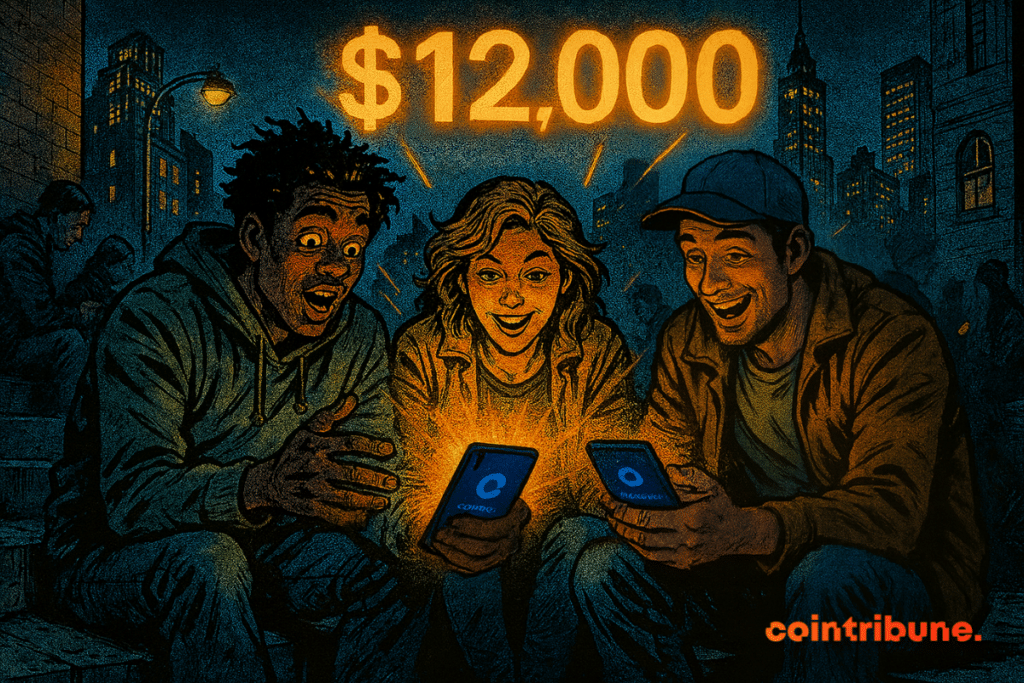Coinbase Donates $12,000 in Crypto to Support 160 Underprivileged Youth
In the crypto-sphere, everyone is getting involved to “democratize”: platforms, NGOs, start-ups compete with approaches to make the digital world more inclusive. Some emphasize education, others redistribution, sometimes both. Coinbase today offers an unprecedented mix: delivering $12,000 in USDC crypto to 160 young New Yorkers. Behind this initiative is a strategy that goes beyond the simple social act: a quest for influence, legitimacy, and economic experimentation.

In brief
- Coinbase offers $12,000 in USDC to 160 New York young people in digital precarity.
- The Future First program mixes unconditional donation, financial education and the use of the USDC stablecoin.
- Recipients can spend, save or convert their cryptos, with fees imposed by Coinbase.
- Coinbase aims for a banking license to redraw the line between crypto and traditional centralized finance.
The social bet of Coinbase: crypto + unconditional donation
Coinbase, in partnership with GiveDirectly, launches a program called Future First. The idea: to offer $12,000 in USDC stablecoin to 160 people aged 18 to 30, with low income. The distribution is done in two stages: $8,000 at once, then 5 monthly payments of $800.
The choice of stablecoin (USDC) avoids the volatility of bitcoin or ethereum but introduces new challenges. Recipients can withdraw to a bank account (with 1.75% fees), use a Coinbase card or let the funds yield an interest of ~4.1%.
An academic critic, Hilary Allen, warns that this could encourage recipients to engage in risky speculation.
This device aims to measure if crypto technology can amplify the impact of classic universal income. But it also carries an implicit educational dimension: teaching these recipients to navigate the crypto world.
Precarity, autonomy and trajectories: who wins?
Focusing the experience on young people in vulnerable situations exposes the project to a strong moral and strategic burden. Among the recipients is Luis Acero, 25 years old. He has already experimented with cryptocurrencies… to his detriment. He had lost several thousand dollars by blindly betting on volatile assets. Today, he wants to turn the page and approach this new opportunity with caution.
A part-time student, he sees in this allocation a lever to regain control: repay debts, save, better understand crypto, and perhaps build a more stable future.
The challenge: to give them real freedom, not a “conditional check.” Indeed, without instructions on the use of funds, these young people can choose housing, studies, or entrepreneurial projects. The injection of $8,000 at once (rather than regular payments) reflects this logic of autonomy: to give a strong initial lever to start a project.
But the pitfall remains: not everyone masters crypto mechanisms. Fees, choices, conversions. Some could hesitate or make mistakes. Coinbase prudently states that they do not recommend individuals invest in risky assets.
The experiment thus questions the digital divide: can technology overcome precarity without creating new inequalities?
Coinbase and banking ambition: when social flirts with the system
All this would not be innocent: Coinbase is exploring a deeper transformation of its role in finance. It is now considering obtaining a federal banking license in the United States. This charter would allow managing its own reserves, launching new products, while opening up to classic banking uses without officially becoming a bank.
Other crypto players are following suit: Circle, Ripple, Paxos or BitGo are also in the ranks. Coinbase, on its side, already works with JPMorgan Chase and the Department of Justice for digital asset management. It also hosts the bitcoins held by BlackRock and Fidelity ETFs. The line between Web3 and traditional finance is dissolving.
Some key figures not to forget:
- 160 young beneficiaries selected in New York;
- $12,000 distributed in USDC stablecoin per person;
- 1.75% fees for withdrawals to a bank account;
- Potential yield of 4.1% on USDC in Coinbase account;
- Coinbase’s banking goal: expand its services with an OCC charter.
Speaking of banks, Coinbase recently wondered: what if stablecoins kill banks? A not-so-innocent question when you see how this platform weaves links between technology, social inclusion, and institutional power. The challenge is no longer just to send money: it’s to redraw the rules of the game.
Maximize your Cointribune experience with our "Read to Earn" program! For every article you read, earn points and access exclusive rewards. Sign up now and start earning benefits.
La révolution blockchain et crypto est en marche ! Et le jour où les impacts se feront ressentir sur l’économie la plus vulnérable de ce Monde, contre toute espérance, je dirai que j’y étais pour quelque chose
The views, thoughts, and opinions expressed in this article belong solely to the author, and should not be taken as investment advice. Do your own research before taking any investment decisions.